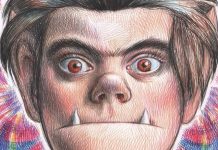Penguin Random House hopes to continue its range of beloved kids comics at C2E2 2020 with its “Awesome New Kids Graphic Novels from Random House” panel. To celebrate some of its works already out there, and reign in the new era, we’ve got Chad Sell (The Cardboard Kingdom), Jeffrey Brown (Jedi Academy), Jessi Zabarsky (Witchlight), Lucy Knisley (Stepping Stones), and Senior Editor Whitney Leopard.
Leopard kicks off the panel with introductions and asks creators to chat a bit about their works and their worst sport!
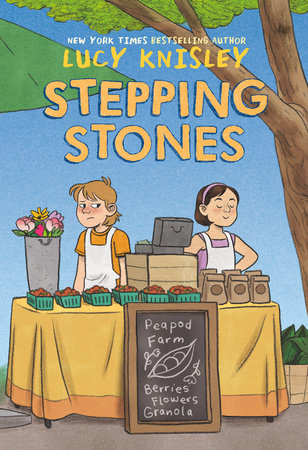
Knisely talks about her upcoming middle grade book, Stepping Stones. It follows a kid named Jen as she moves from the city to the farm and learns how to navigate her new step-dad and step-sisters. On the topic of her worst sport, she says “most!” but specifically she remembers her basketball tenure being cut short by a certain magnetism between the ball and her head.
Sell takes the point and adds that he, too, is a basketball drop-out. His next book, Doodleville, comes out in June and explores creativity, one of his favorite subjects. In a nutshell, the story involves a girl whose doodles come to life and run amok in Chicago.
Brown, who’s resume includes a handful of Star Wars books, is now preparing to launch Once Upon a Space-Time. He says it involves two kids, an intergalactic spaceship and absolutely no grown-ups. As a budding t-ball player, Brown was given extra strikes and remembers other teams being thrilled when he was up to bat.
Zabarsky wraps introductions smoothly, adding that every sport is her worst and pitching Witchlight as a book about a witch and her friend with Miyazaki-vibes, lots of feelings-chats, cut with food and swordfights.
From there, Leopard moves on to the more structured portion of the panel, asking questions for each of the creators.
Why graphic novels?
Knisely’s experience making comics begins in first grade, when her teacher showed her how simple it was to fold and staple paper together into a zine. Her first comic, she jokes, was a direct rip-off a book about snakes. She traces her fear of snakes all the way to her current work, saying that graphic novels are the perfect way for her to process emotions through words and images.
Sell’s experience is a bit windier. He experimented with a few other art forms, including film, but quickly came to realize how much time was involved in such a feat. The finished product can be years off from the original idea and look nothing like it was intended to. With comics, though, Sell appreciates the instant gratification, as well as how true-to-form a book is as a result. Publishing takes time, of course, but the fact that it exists is enough for Sell.
Brown agrees with the notion of instant gratification in writing and drawing. He loves being able to fiddle endlessly with his art and being able to immediately see how it changes.
What’s a kids’ book you’d recommend to others and what’s one you wish you had growing up?
Sell admits it’s hard to find just one, but a creator here at C2E2 he recommends is Peter Wartman, who’s behind self-published comics like Over the Wall and Stonebreaker and also worked on Avatar: The Last Airbender with Faith Erin Hicks.
Brown’s recommendation is a comic from the 70’s called Yellow Yellow. Writer Frank Asch and artist Mark Alan Stamaty both have amazing detail and humor, and would become big influences on his own work. Although he says the level of quality in children’s comics is so high right now that you could walk into a store, pick up anything off the shelf and be happy, he can’t help but mention Smile from Raina Telgemeir. It’s the type of personal narrative he would write eventually, but never realized he could when he was a kid.
Knisely says she grew up with stuff like Archie, though never had girl characters until she was in high school. That’s when she found Lynda Barry and saw what she was missing out on as a kid. Along with things like beat poetry, Barry’s work became a huge inspiration for her.
Chad, what’s your inspiration for Doodleville and what is it that makes your heartfelt characters so special?
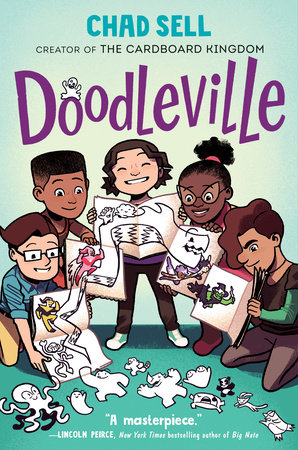
Sell starts off saying that writing characters means letting them live in your head with you. By drawing and telling stories about them, you give them life – and sometimes they don’t do what you want them do! That’s the premise and inspiration of Doodleville. It’s a book that deals with the magic of creativity and its channeling of doubt and insecurity. It’s a miracle that we’re able to make whatever we want, but so many of us are tormented by the thoughts of others’ reactions. In his work , he hopes to emphasize kids’ creativity, so that it doesn’t burn out. That’s why so much of what happens in his books, readers can do in real life – so that kids never forget how to turn the mundane into magic.
What’s surprised you about the process of making graphic novels?
Immediately, Brown says he’s surprised more often than not, especially when it comes to how he imagines something will look versus the finished product. Like Sell mentioned, sometimes characters don’t do what you want them to do. They become friends instead of rivals, you do something mean to try and undo that and they’re still clever enough to become friends again! They take on complete lives of their own.
Knisely’s surprise comes from the ease of writing for a younger crowd, considering she had primarily written for adults in the past. She easily channeled her inner 14 year old without having to change much at all. The story she wanted to tell was a fan-fic of her own life, albeit with some minor tweaks. Knisely admits her step-dad was a jerk. And dealing with jerks is a tough reality for kids, because they typically have no control over the people they’re around. Adults can easily walk away from a situation, but children don’t have that option. So, she hopes this story of her step-sisters standing by her side will help readers in the position she was in. Even if that wasn’t necessarily how it happened.
Jeffrey, your comics are consistently both funny and heartfelt. How do you balance the two?
“I don’t know!” Brown responds quickly and hilariously. He says he’s a sensitive person, for better or for worse and he suspects that makes it easy to inject humor into his books. Practice for him involves telling his kids purposefully horrible jokes, then making is a goal to actually make them laugh in the final draft. Brown adds that it’s important to write from the heart and to wear emotions on the sleeve.
How do you all decide on formats? Does this question arrive before, after or during the writing process?
Brown says he always likes to know beforehand. There’s one book of his, for example, that involves a neaderthal, so he wanted a stout book with torn pages, so it would resemble the contents. In other cases, though, it comes down to efficiency. He gives the example of choosing black and white over color formats, simply for the sake of being able to finish longer books on time.
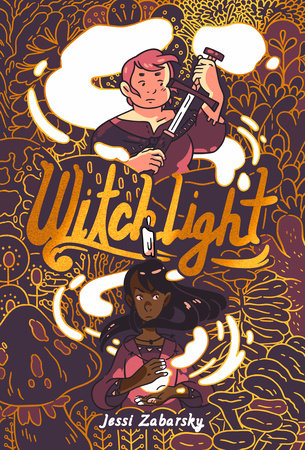
For Zabarsky, the question relates more to page length than anything else. Witchlight was created to be an 18 page zine; just something new to present at a con. But, she quickly realized there was more to her story than she anticipated and a gaping hole of possibility between the beginning and end. She couldn’t help but turn the project into a fully-fledged graphic novel.
No spoilers! What’s your favorite thing about your book?
Knisely: “Kittens!”
Doodleville introduces Sell’s imaginary friends to the real world, which he can’t help but be excited about.
Brown loves his robots and aliens, which he tried to make as abnormal as possible – but he suspects each one has a little bit of him in them.
Lastly, Zabarsky’s alludes to secret little symbolisms in Witchlight, especially in haircuts, repetition of perspective and phases of the moon.
Jessi, Witchlight is aimed at a slightly older audience than others here. How did you come to that decision?
It seems that the characters made this decision all on their own. Zabarsky created this story with people the age she was when she started it, simply because she hadn’t drawn humans in a long time. Witchlight is her way of working through her late teens and early twenties with a mindset of not knowing what you’re doing, but still moving onward and trying to figure it all out.
Lucy, Stepping Stones follows a city kid forced into a farm, which lots of adults fantasize about. What aspects of that experience did you want to highlight?
Knisely explains that the farm is a metaphor for finding the good. Having grown up there herself and now a city dweller once again, some definite thought went into the decision of raising her kids in the city. There’s a disconnect for city kids and food, though, that she especially wanted to make clear. Seeing that process reminds readers food comes from people and animals and labor. Although some adults romanticize farm life, Knisely says it can be terrible for a kid. Just like anywhere else, and in life, there’s always god and bad.
On the topic of personal history, Jeffrey why space travel?
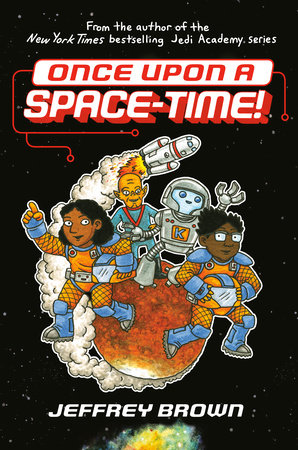
Brown fondly remembers when shuttles would launch on a school day. Teachers would wheel in big TVs and the class would all watch together. He was always interested in sci-fi, watching Star Trek and thinking about what space exploration would look like in the future. That is, until he started reading science books and discovered that most scii-fi is actually impossible. With Once Upon a Space-Time, he wants to find a way to think about space exploration positively again – to be able to look at the moon and feel amazement again.
Wrapping up the Random House 2020 panel, what advice do you have for those who want to make their own graphic novels?
After some deliberation, the panel comes to the consensus that it begins with reading. See what you like and don’t like, but always try to put on the page your own perspective of the world. Then, start small with some sketches and maybe a mini comic. Build your comic making muscles and use what you learn to make bigger, more ambitious comics. Zabarsky tells the audience that whatever keeps you putting lines on the page is what you should keep doing.



